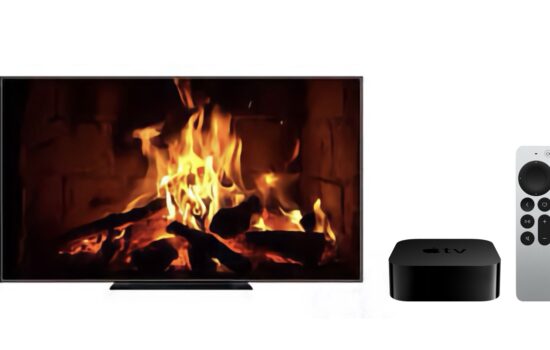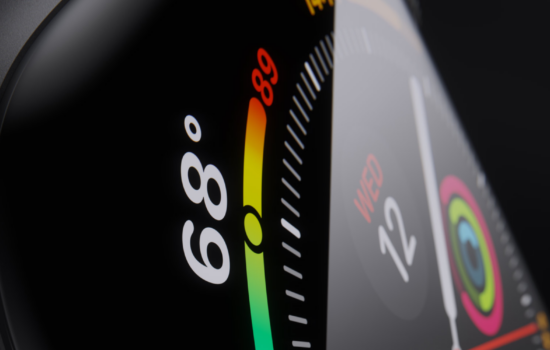I just recently went through the first major, legitimate heartbreak of my life. I had to break up with someone who could have been the love of my life over some key compatibility issues that made staying together feel impossible. The worst part: it was amicable. It destroyed me, but you have to take things day by day. I’m fine, I think. I lived. And anyway, this isn’t a relationship advice forum—I’m supposed to be talking about Apple.
My Vision Pro hasn’t received much love this year. Besides giving demos to friends and keeping it up to date, it has mostly stayed powered off. I love the device, but there’s just not much to do on it. One new app did catch my eye, though—one featuring the work of one of my favorite artists, Björk. The visionary experimental Icelandic singer-songwriter has always made an effort to utilize the latest technology in her music: a series of iPad apps accompanied her 2012 album Biophilia; her 2017 album Utopia came with cryptocurrency; and most recently used AI to power a sound-driven museum exhibition that sparked controversy among some fans. Hell, she even helped create her own singing Tesla coils that she brought on tour back in 2011.
The best example of this, however, would be her Vulnicura VR experience. Adapted from her critically acclaimed fan favorite 2015 album Vulnicura, it consists of a series of experiences to symbolize each song—with some being 360-degree videos and others being more interactive experiences. The experience toured around the world as part of the Björk Digital exhibition. One of the visuals even won the Cannes Lions Grand Prix Award for “Real Time Virtual Reality Experience.” The app officially released to consumers through Steam a few years later with the full set of experiences included. I knew it was only a matter of time until the experience made its way to Apple Vision Pro.
Since Apple has launched Apple Music, they’ve gone to great lengths to partner with artists and fold them into their ecosystem. Björk is one of the most recent examples, and she has become an Apple poster child. She played a DJ set last year on New Year’s Eve that aired on Apple Music 1. Early this year, Apple distributed a version of her “Cornucopia” concert film through Apple Music Live, and she sat down for a rare on-camera interview with Zane Lowe to promote it. Around the same time, she called Spotify “the worst thing that has happened to musicians” in an interview—a comment that, intentionally or not, aligned neatly with Apple’s messaging that its platform is better for artists. She also got her full catalogue remixed for Dolby Atmos and made it available on Apple Music.
It’s only natural, then, that Vulnicura VR came to Apple Vision Pro. VR music firm PulseJet Studios remastered the experience with new visuals, hand-tracking controls, and ‘enhanced’ spatial audio—though it comes by way of PulseJet’s Auro 3D tech, not Dolby Atmos. The new experience was released a few weeks ago for Apple Vision Pro and Meta Quest with a price tag of $44.99—an increase over the original version’s initial $29.99.
I thought it was a no-brainer that I had to purchase this app and try it out. I consider myself to be a superfan of Björk—she’s been my number one artist almost every month this year on my Apple Music Replay, with almost 4,000 minutes listened this year alone. I listened to her music through good times and bad, with Vulnicura itself being the soundtrack of a previous months-long difficult relationship, as well as my separate and most recent breakup. Oh, did I mention that it’s a breakup album?
I had been sitting on this app for quite a while, but my most recent breakup felt like the perfect time to experience this album in this format, with my emotions still raw. The album and VR app are presented in chronological order with timeframes of when each song was written through her heartbreak, so I wanted to see if I could maybe connect the experience to my own in any new way and journal my thoughts. And I might as well publish them to the internet, while I’m at it. I love oversharing.
I jumped into the app on my M2 Vision Pro—you know, the one that Apple sent me under my limited warranty after I experienced the ‘crackgate’ phenomenon. The app also recommends you use headphones for the experience, so I used my AirPods Pro 3, which are supposed to support a lossless connection to Vision Pro. The first thing you see in the app is a series of teleportation ‘totems’ lined up through an Icelandic landscape. The app’s developers say the terrain is based on LiDAR scans of real places, and that all the details down to the moss are improved in this new version. You jump to a totem by looking at it and pinching, and each totem plays a sample of its respective song’s string arrangement. I felt a pit in my stomach hearing the song start to play—I had no idea what this all might make me feel.
Track 1: Stonemilker (9 months before)
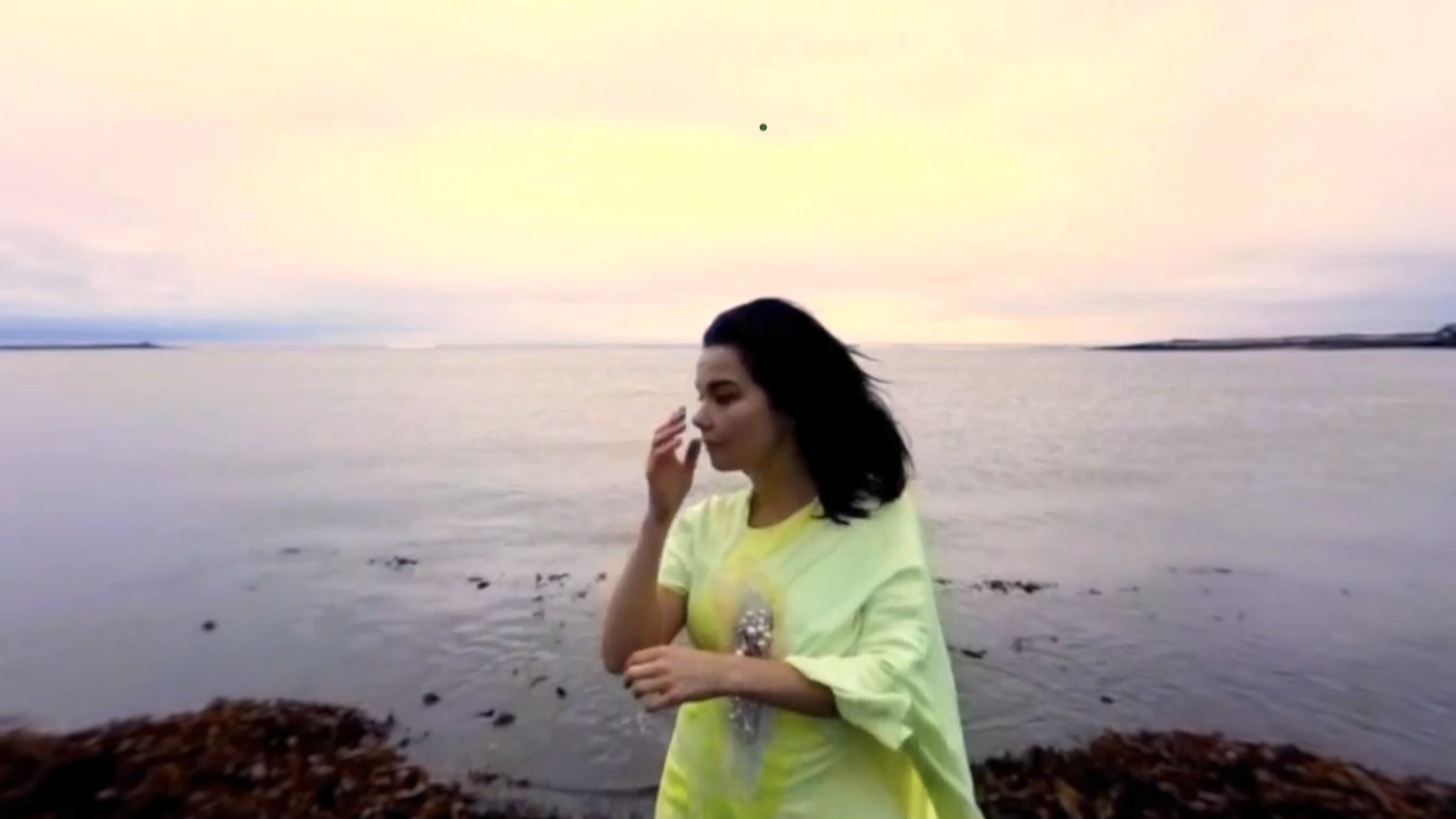
The first track is probably the best known from the album, and one of my personal favorites. This experience is a 360-degree virtual reality video where multiple Björks weave in and out of existence all around you as they sing along beaches in Iceland. The videography is definitely of its time—the stitching between angles is rough, the resolution low, and the scaling makes Björk appear larger-than-life and distorted.
Technically, the spatial audio jumps out—though the mixing is a little hollow, Bjork’s voice follows each of her on-screen appearances, unlike in the Dolby Atmos mix available on Apple Music. Disappointingly, this version does not include Arca’s soft shuffling percussion that really makes the song for me. However, Björk says she made this choice to emphasize the strings—which were each individually recorded with a clip-on microphone and fanned out spatially in the mix.
The video grounds the emotional tone of the track. She opens with the lines “a juxtapositioning fate/find our mutual coordinates” and demands emotional respect. The song is a sweeping ballad, and being in this landscape on the water with such immersive tech helps draw you into the song in a way I never felt when I overplayed it on my hardest days. The words “Like milking a stone/to get you to say it” reminded me of my first relationship. What really stuck out to me this listen was the theme—of two people who just can’t find common ground and latch onto the rare moments of joy when they do.
No comment.
Track 2: Lionsong (5 months before)

Lionsong, at first glance, does not seem to benefit much from the virtual reality experience. It’s based around the flat music video for the song; you watch it from a black room through a cutout shaped like the hole in Björk’s outfit at her chest. Much of the video is spent looking at the pulsating inside of her chest—symbolic of her heart being ripped out. It’s a recurring theme on the album, where she calls herself ‘open-chested.’
There’s not a lot going on here spatially, though there is a mild depth effect separating the video from the cutout. The more I watched the video, however, I realized that virtual reality has a unique way of imposing scale upon you—the cutout’s placement almost makes you feel like you’re looking up at a giant stained-glass window from inside a dark church. The darkness is heavy and isolating, like you’re watching through prison bars. It captures the feeling of the song, which is about the uncertainty of going through a hard time with your partner: “maybe he will come out of this loving me…or he will feel solitaire/somehow I’m not too bothered/I’d just like to know.” It’s a feeling I’ve come to know all too well. This experience put me back in this place of feeling trapped, not sure how to move forward—afraid to do anything, that it might make my situation worse.
Track 4: Black Lake (2 months after)
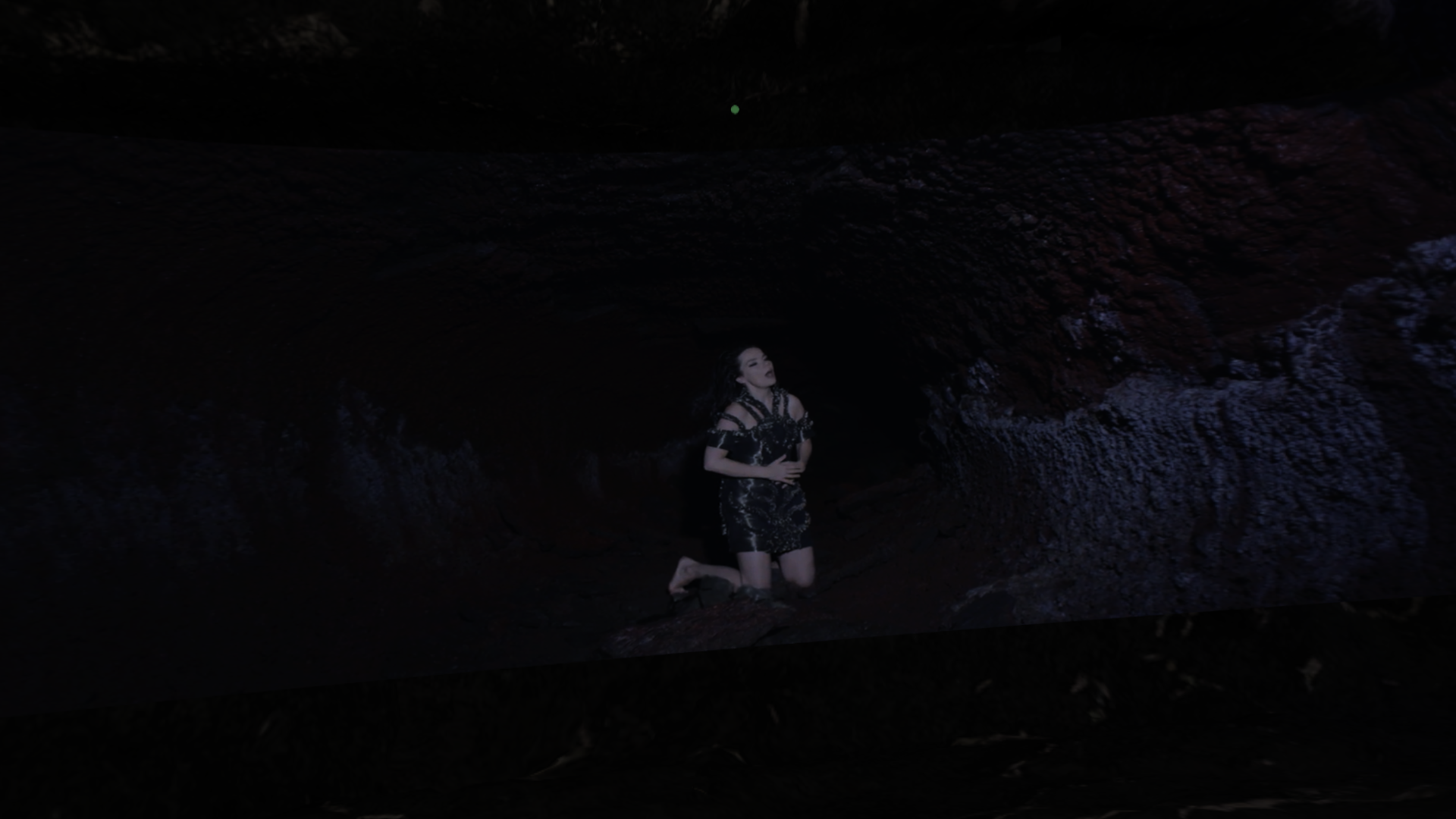
This experience showcases two 2D music videos for the song on either side of the cave where the song’s totem is located. These videos showcase Björk symbolically at her lowest inside of a cave, emerging as she makes a realization: “you have nothing to give.” She depicts heartbreak metaphorically through volcanic rock: it’s hot at first, but once it cools down, it changes the landscape to one where grass has been able to grow.
I related to this experience the least. Part of that had to do with the song; though I could relate to many of the lyrics about differences in partners, some parts dealt with family dynamics—something I can’t understand as a childless 23-year-old. But the VR experience also did not help—there was no real need for this to be in virtual reality other than to round out the album. I also found this one quite painful to watch—the videos are positioned to your left and right, and I was lying in bed while I experienced this, which meant craning my neck 90 degrees for the song’s more than ten-minute runtime. Ow.
Track 5: Family (6 months after)

This is the most immersive and technically impressive so far. The bulk of the experience has you floating through a cavern behind a massive representation of her… well, it’s better not to sugarcoat it—her vagina. When you pinch your fingers, threads come out of it and wrap around your arm. It relates to the core theme of the song: “There is the mother and the child/Then there is the father and the child/But no man and a woman/No triangle of love.” Björk, in volumetric 3D form, sings along to the song and moves around the space. The experience transforms as the song changes, with rocky models of Björk’s body tumbling through space in what looks like a mudslide as you rise to the surface. As the song ends, she dissolves into a series of threads.
This experience is the standout so far and one I will definitely revisit, though maybe not the first I’ll show to friends for obvious reasons. Even though the interactive elements are simple, there’s just so much to look at here. It’s visually stimulating, dynamic, and just so impressive. Even though the song’s themes don’t reflect my own life, the emotional clarity still landed.
Track 6: Notget (11 months after)

This is the most acclaimed experience from the collection—and for good reason. It’s visually stunning, with a volumetric Björk even more realistic than in “Family.” Her face model bears a striking resemblance to her real self. This track features the singer dancing to the electronic beats as the rocky landscape around her floats away. The thing you can feel here is the intense pain—threads of bright orange light swirl around her and grow more prominent as the landscape fades away.
It does help that this song represents a pretty universal experience in heartbreak that I know I went through—remembering the good as well as the bad through the healing process and mourning the love that you no longer receive. It’s best emphasized in the chorus: “I will not forget/This notget/Will you not regret/Having love let go?” Not only is this song a standout on the album, but this experience is one that will burn into my brain—I’ll never be able to hear this song without picturing these visuals in my head.
Track 8: Mouth Mantra

Note that this track does not feature a dated reference as a subtitle—we’ve moved past the narrative about her breakup. Björk says this song is about a period after vocal surgery where she was unable to use her voice. The experience that represents this is frightening: it’s a 360-degree video from the inside of a mouth. The camera bounces and rolls around quickly—it’s not for those prone to motion sickness. At the end, you begin to see Björk dancing and singing outside through the teeth, and eventually it switches to a flat video projected into the 360-degree viewing area. It’s certainly a unique and thrilling experience—but it’s hard to compete with the two that came before.
Track 9: Quicksand
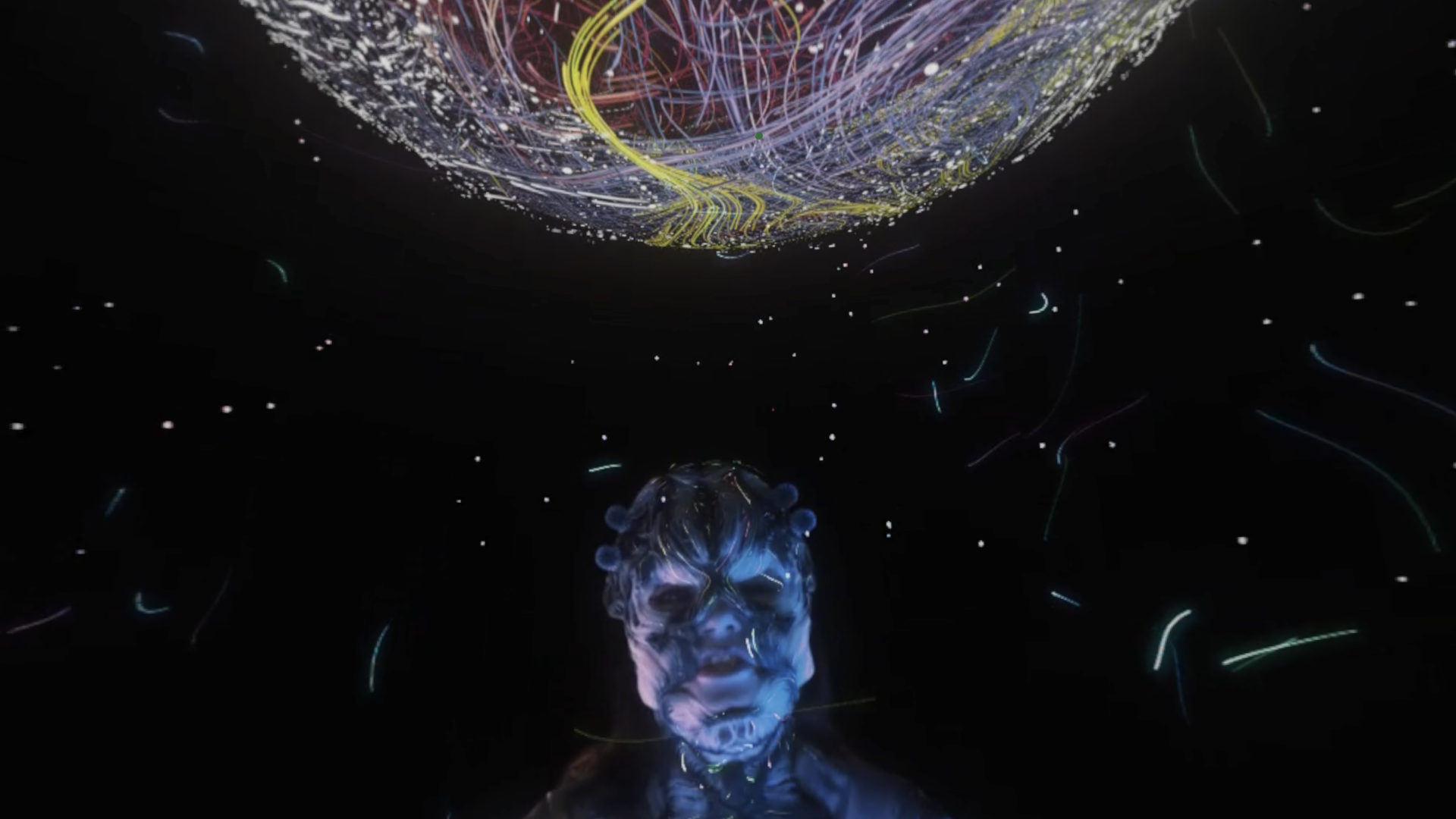
The final track on Vulnicura is about Björk’s experience almost losing her mother to a heart attack: “Our mother’s philosophy/It feels like quicksand/And if she sinks/I’m going down with her.” This experience is a 360-degree video that sounds to be a live performance—it features new raw vocals that are blown out at times. This video is probably the strongest of the 360-degree videos—a thrilling trip through outer space as Björk dissolves into glowing lines and particles. It helps that this is one of my favorite songs on the album. This one will definitely make a great demo.
Final Thoughts
Having finished all the tracks, some key details about the experience jumped out to me.
First, your arms: they’re represented by glowing wireframes. They do not go away, ever—even in the experiences. If you cross your arms in front of you or place them out of good view of the cameras, they start glitching out. It becomes insanely distracting at times when you just want to relax and watch the videos. Fortunately, I started learning to wave my arms around when I sang my favorite songs back to Björk standing in front of me—but any song that I didn’t know well enough to sing suffered from this problem.
Second, stability. The software crashed three times while writing this review, and more times before that when dabbling around and setting it up. Sometimes it would just crash on opening; others, it would crash when starting an experience. The reliability is rough here. Thankfully, there’s no progress to lose, but it still takes a while to get back into the experience each time.
Finally, you may have noticed I skipped some entries on the tracklist. That’s because not every song has a VR experience—“History of Touches” and “Atom Dance” are not represented here. These songs only have a ‘score’ experience which is supposed to allow you to watch the sheet music play back. I say ‘supposed to’ because they barely worked—“History of Touches” wouldn’t load at all, and I struggled with various others at different times. I’m not sure if this is just an issue on my end, but it is disappointing that there’s essentially no working experience for “History of Touches,” which is part of the album’s main story arc.
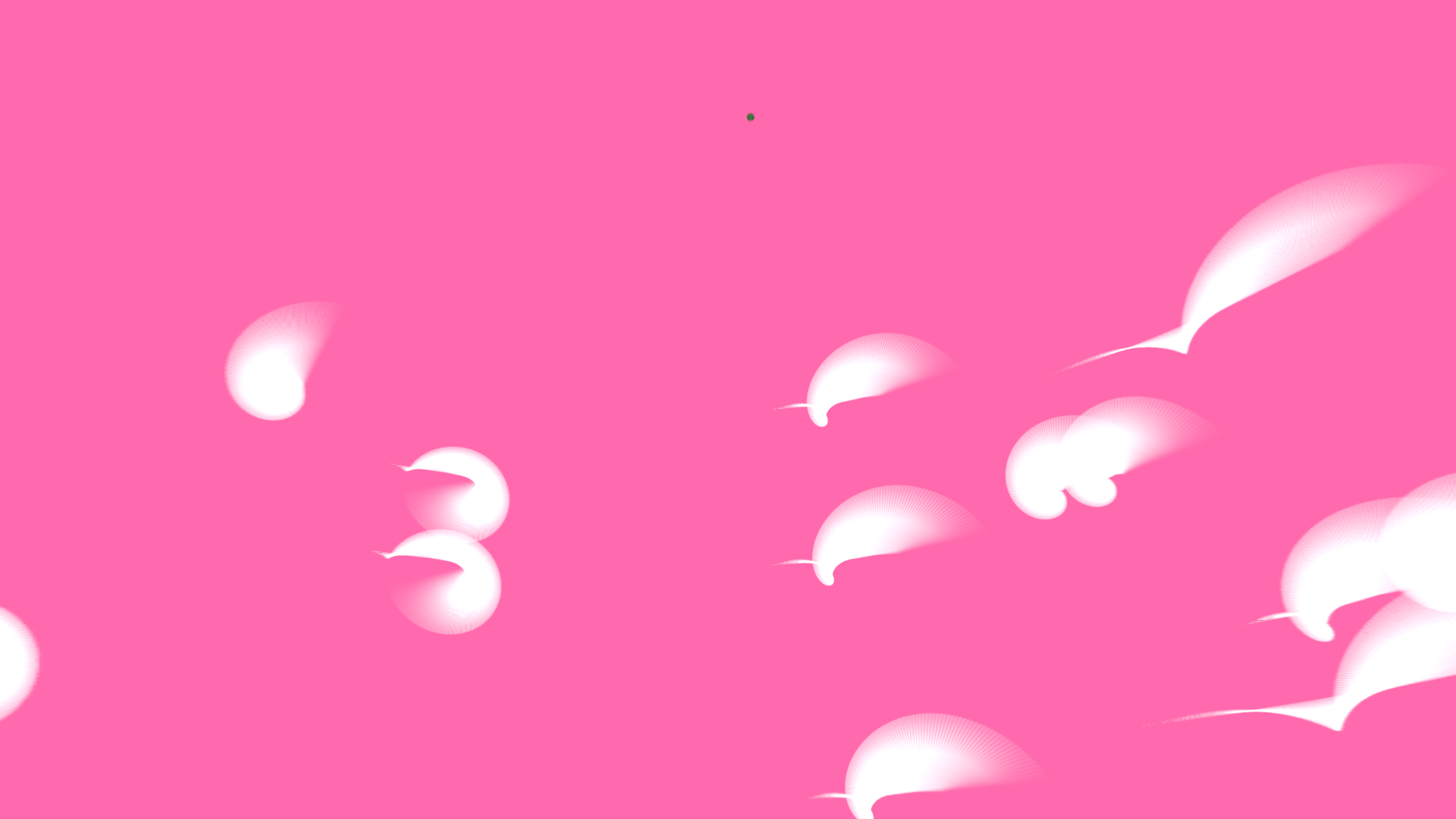
Overall, I thought this was a great experience. I do understand why she made it, and its creation felt justified most of the time. Until now, virtual reality has been simply too niche for cohesive experiences with high artistic value. Outside of gaming experiences like Half-Life: Alyx and BONEWORKS, most VR experiences are small-scale tech demos to show what the tech can do as we all wait for it to catch on. Björk clearly did this because she wanted to, and she could—it’s a high art, avant-garde experience with a budget made within the emerging technology. I can’t point to many other examples of that. She is exactly the kind of artist I imagine Steve wanted Apple’s technology to empower—the kind of person who belongs in a modern “Think Different” campaign.
If you have a Vision Pro, I might recommend this experience to you. It’s important to try Björk’s music before you pay the $44.99 price tag—some find her music to be abrasive and her voice obnoxious (just ask my family, friends, or the very ex this article is about). The price is certainly steep for what you get, but for someone who is open-minded to art and likes to try new things, there is very little else like this. It’s very rare for interactive media to convey such raw emotion, and though it didn’t grant me the catharsis I was hoping for, I definitely connected more deeply to my favorite songs through the visuals.





